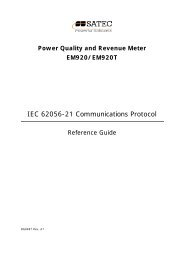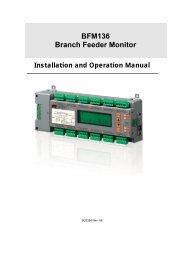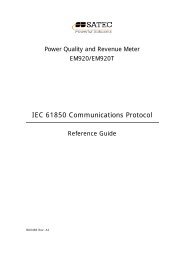You also want an ePaper? Increase the reach of your titles
YUMPU automatically turns print PDFs into web optimized ePapers that Google loves.
Common File Transfer<br />
Log files can be read either in a sequence record-by-record, or in a random order. Each Read-<br />
File request fills the file response block with the data of the record pointed to by the file (or<br />
section) read pointer. If you want to begin reading a file from a particular record, which<br />
sequence number is known, you can change the pointer position by issuing the Set-File-Position<br />
request with the desired sequence number. If you want to read a file from the beginning, send<br />
the Reset-File-Position request that moves the pointer to the oldest file record. If you do not<br />
change the file position, then you will continue reading the file from the record following the one<br />
you have read the last time you accessed the file.<br />
You need not explicitly move the file position to the following record if you want to continue<br />
reading a file in sequence after you have uploaded the current record. Instead, issue an<br />
acknowledgment request that automatically advances the file pointer to the next record, and<br />
then read the record data through the file response block.<br />
The file response block can contain more than one record. The number of records available in<br />
the block and the file record size in words are always reported in the block heading. There are<br />
no special rules on how to read records from the file transfer block. You can read a single record<br />
or all records together, or begin reading from the last record and end with the first record.<br />
However, you should remember: 1) after an acknowledgment, the file position moves to the<br />
record following the last one you have accessed in the file transfer block; and 2) data in the file<br />
transfer block does not change until you either issue an acknowledgment, or explicitly change<br />
the file position by the Set-File-Position or Reset-File-Position requests.<br />
The file transfer is completed after you have read the last record of the file. Before storing a file<br />
record to your database, always check bit 9 in the record status word, which contains the endof-file<br />
(EOF) flag. This bit set to 1 indicates that the file read pointer does not point to any<br />
record within the file, and you should not store any record that has this bit set. The EOF flag is<br />
set only after you have acknowledged the last record of the file, so that testing for end-of-file<br />
requires one extra read. If you wish to stop the transfer just after storing the last file record,<br />
acknowledge the record and check bit 0 in the record status word. Bit 0 is set to 1 only once<br />
when you read the last record of the file.<br />
The following gives a summary of steps you should do to read an ordinal log file:<br />
1. If you wish to begin reading a file from a particular record or from the first record, use<br />
either the Set-File-Position request with the desired record sequence number, or the Reset-<br />
File-Position request. Preset a section number and channel ID to zero.<br />
2. Write the Read-File request with a section number and channel ID set to zero.<br />
3. Read the record data from the file response block.<br />
4. Write an acknowledgment for the file. You need not fill all the request fields: only the file<br />
function is required. The file pointer will be moved to the next file record.<br />
5. Repeat steps 3-4 until all the file records are read.<br />
Reading Multi-section Profile Files<br />
In a multi-section data profile file, all user requests including an acknowledgment; the Read-<br />
File, Set-File-Position and Reset-File-Position requests, relate to a particular file section rather<br />
than to the file itself.<br />
A file section can be requested either by a section number, or by a section channel ID. If you<br />
use a channel ID, preset the section number field to 0xFFFF. If a section number is specified,<br />
the channel ID field will not be checked. The <strong>BFM136</strong>/036 returns both fields in the response<br />
block heading, so you can always identify what channel data is being read from the present file<br />
section. If you want to know which channels are recorded to the file sections, check the file<br />
channel mask in the file info block. This is a bitmap that contains one in a bit position if a<br />
channel with an ID equal to the bit number is recorded to the file, and contains zero if it is not.<br />
The following gives a summary of steps for reading a multi-section data log file:<br />
1. If you wish to begin reading a file section from a particular record or from the first record,<br />
use either the Set-File-Position request with the desired record sequence number, or the<br />
Reset-File-Position request. Specify either a section number, or the channel ID for the<br />
section from where you want to read data. If you use a channel ID, preset the section<br />
number field to 0xFFFF.<br />
12





